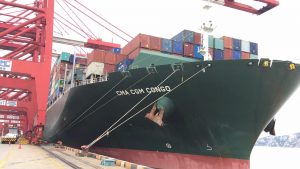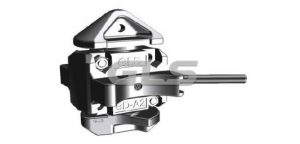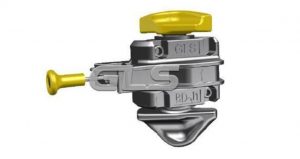
The most commonly used container twistlocks can be divided into three categories: manual lock, semi-automatic lock and automatic lock. So what are their categories and their strengths and weaknesses?
First of all, let’s understand the classification basis of these three types of container locks. As the name suggests, manual, semi-automatic, automatic, is certainly according to the degree of automation of the operation mode to do the classification. Generally speaking, the loading and unloading of containers and locks can be divided into three steps: loading lock → packing (locking) → unloading box (locking) → unloading lock. The first step and the last step to load and unload the lock are all manual for three types of containers, except the operation mode is different. The key lies in two, three and two steps. The locking and unlocking of the manual lock should be operated manually. Semi-automatic locking is automatically locked after packing, and manual locking is required before unpacking. Automatic lock in the process of packing and unloading without manual intervention, automatic lock and remove.
Then, we analyze their advantages and disadvantages by their respective usage.
First, let’s look at the manual twistlock. The following figure is Manual twistlock from GLS:

When using, the manual twistlock is manually placed in the lock hole of the vertical base on the deck, or the worker climbs to the top of the container, places the manual lock in the lock hole of the top of the container, and then the container falls on it. The worker manually or USES a special tool again, or climbs to the top of the container to use the tool again, and pulls the handle of the manual lock to close the lock. When unloading the container, the worker still manually or USES the tools, or climbs to the top of the container to use the tools, and pulls the handle in the other direction to open the lock. After opening the lock, the box will be lifted off, and the manual lock will be kept on the lower lock hole. The worker shall also remove the manual lock for lifting the lower box.
From the above manual twistlock operation description, it is not difficult to see that the manual lock operation is tedious, each step requires manual intervention, and the loading and unloading efficiency is low. Also, personnel have to repeatedly operate on the top of the box, greatly increasing the risk of falling. More and more classification societies and relevant international organizations have become more stringent in terms of personnel safety requirements, such as the United States’ OSHA standard (Occupational Safety and Health Standard), which requires personnel to work at a height of more than 1.8 meters with corresponding safety measures. Then, if a ship needs to comply with OSHA standards, that means manual locks will not be used between tall containers.
Then, the manual twistlock is still quite widely used also must have its advantages. It is to compare price a few cheaper than other lock kind above all, the price difference that large quantities of purchase its also is not a small number. Secondly, the manual lock structure and principle is simple, not easy to damage, maintenance is also convenient. Therefore, on the premise of ensuring the safety of operators, manual locking is a fairly economical and reliable option for some small ships, which have a small number of container layers and do not have rigid regulations such as OSHA.
Secondly, let’s look at the semi-automatic twistlock. The following figure is semi-automatic twistlock from GLS:
To use a semi-automatic lock, first lift the container and insert the lock into the 4 holes at the bottom of the container. Then, the lock is placed in the corresponding keyhole position on the ship (the keyhole on the deck or the keyhole on the top of the lower container) along with the container. , Semi-automatic lock automatically locks without manual intervention. When unloading the box, the personnel pull the cable of the semi-automatic lock on the deck manually or use a special operating rod to unlock, and then the lock is still hung on the bottom of the box and lifted off the ship together with the box.
As can be seen from the above description, the automatic feature of the semi-automatic lock is that it automatically closes the lock without manual intervention after the container is loaded, but it still needs to be manually unlocked when unloading the container, so it is called a semi-automatic lock. Compared with manual locks, semi-automatic locks basically solve the pain points of manual locks. One is to reduce manual operations and greatly improve the loading efficiency of the terminal. The other is that personnel no longer need to climb to the top of the container to operate, and there is no risk of falling.
The disadvantages of semi-automatic locks are relatively the advantages of manual locks. The price is slightly more expensive and the structure is slightly complicated. However, the industry application semi-automatic lock solution is very mature, and the product reliability is no worse than manual lock.
Finally,let’s look at fully automatic lock.
The locking and packing process of the fully automatic lock is similar to that of the semi-automatic lock. First, the container is lifted, and the personnel insert the fully automatic lock into the 4 holes at the bottom of the box according to specific requirements, and then hoist it along with the box to the corresponding keyhole position on the ship. The automatic lock automatically locks without manual intervention. Then it is unloading. Unloading requires the lifting force of the crane to reach a certain critical value, and then the automatic lock is automatically released to complete the unlocking. The lock is hung on the bottom of the box and lifted off the ship with the box. Because there is no manual labor during the process of loading, closing, and unloading, it is called fully automatic lock.
The advantage of fully automatic locks is that more automated efforts have been made on the basis of semi-automatic locks, which further improves the loading and unloading efficiency of the terminal, which is the future development direction of container lashing.
However, there is a huge flaw in the automatic lock industry that has not yet been resolved, that is, its unlocking depends on the lifting force to reach a certain critical value and automatically release. This critical value is safe for most ships during navigation, but it is still not possible to rule out the possibility of excessive container angular inertia lifting force during the navigation of the ship that may cause the container to fall off under some extreme sea conditions.
In conclusion, various types of container locks have their own advantages and disadvantages. The future development direction of the industry must be automation, but there is still a long way to go. At present, the semi-automatic lock solution is relatively perfect.
